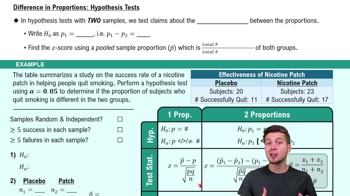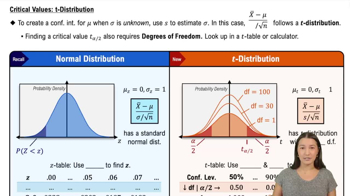Identifying Hypotheses In a randomized clinical trial of adults with an acute sore throat, 288 were treated with the drug dexamethasone and 102 of them experienced complete resolution; 277 were treated with a placebo and 75 of them experienced complete resolution (based on data from “Effect of Oral Dexamethasone Without Immediate Antibiotics vs Placebo on Acute Sore Throat in Adults,” by Hayward et al., Journal of the American Medical Association). Identify the null and alternative hypotheses corresponding to the claim that patients treated with dexamethasone and patients given a placebo have the same rate of complete resolution.
Table of contents
- 1. Intro to Stats and Collecting Data1h 14m
- 2. Describing Data with Tables and Graphs1h 55m
- 3. Describing Data Numerically2h 5m
- 4. Probability2h 16m
- 5. Binomial Distribution & Discrete Random Variables3h 6m
- 6. Normal Distribution and Continuous Random Variables2h 11m
- 7. Sampling Distributions & Confidence Intervals: Mean3h 23m
- Sampling Distribution of the Sample Mean and Central Limit Theorem19m
- Distribution of Sample Mean - Excel23m
- Introduction to Confidence Intervals15m
- Confidence Intervals for Population Mean1h 18m
- Determining the Minimum Sample Size Required12m
- Finding Probabilities and T Critical Values - Excel28m
- Confidence Intervals for Population Means - Excel25m
- 8. Sampling Distributions & Confidence Intervals: Proportion1h 12m
- 9. Hypothesis Testing for One Sample3h 29m
- 10. Hypothesis Testing for Two Samples4h 50m
- Two Proportions1h 13m
- Two Proportions Hypothesis Test - Excel28m
- Two Means - Unknown, Unequal Variance1h 3m
- Two Means - Unknown Variances Hypothesis Test - Excel12m
- Two Means - Unknown, Equal Variance15m
- Two Means - Unknown, Equal Variances Hypothesis Test - Excel9m
- Two Means - Known Variance12m
- Two Means - Sigma Known Hypothesis Test - Excel21m
- Two Means - Matched Pairs (Dependent Samples)42m
- Matched Pairs Hypothesis Test - Excel12m
- 11. Correlation1h 6m
- 12. Regression1h 50m
- 13. Chi-Square Tests & Goodness of Fit1h 57m
- 14. ANOVA1h 57m
9. Hypothesis Testing for One Sample
Steps in Hypothesis Testing
Problem 11.2.4
Textbook Question
Right-Tailed, Left-Tailed, Two-Tailed Is the hypothesis test described in Exercise 1 right-tailed, left-tailed, or two-tailed? Explain your choice.
 Verified step by step guidance
Verified step by step guidance1
Understand the context of the hypothesis test: Determine whether the problem involves testing if a parameter is greater than, less than, or simply different from a specific value. This will guide the choice of tail direction.
Recall the definitions of the types of hypothesis tests: A right-tailed test is used when the alternative hypothesis (H₁) states that the parameter is greater than a specific value. A left-tailed test is used when H₁ states that the parameter is less than a specific value. A two-tailed test is used when H₁ states that the parameter is not equal to a specific value.
Examine the alternative hypothesis (H₁): Identify the inequality sign in H₁. If it uses '>', it is a right-tailed test. If it uses '<', it is a left-tailed test. If it uses '≠', it is a two-tailed test.
Consider the research question or claim being tested: The direction of the test depends on whether the claim is about an increase, a decrease, or simply a difference in the parameter being studied.
Conclude the type of test: Based on the inequality in H₁ and the context of the problem, classify the test as right-tailed, left-tailed, or two-tailed, and explain your reasoning clearly.
 Verified video answer for a similar problem:
Verified video answer for a similar problem:This video solution was recommended by our tutors as helpful for the problem above
Video duration:
2mPlay a video:
Was this helpful?
Key Concepts
Here are the essential concepts you must grasp in order to answer the question correctly.
Hypothesis Testing
Hypothesis testing is a statistical method used to make decisions about a population based on sample data. It involves formulating a null hypothesis (H0) and an alternative hypothesis (H1), then using sample data to determine whether to reject H0 in favor of H1. The outcome helps in understanding if there is enough evidence to support a specific claim about the population.
Recommended video:
Guided course

Step 1: Write Hypotheses
One-Tailed vs. Two-Tailed Tests
In hypothesis testing, a one-tailed test evaluates the possibility of the relationship in one direction (either greater than or less than), while a two-tailed test assesses both directions. A right-tailed test looks for evidence that a parameter is greater than a certain value, whereas a left-tailed test checks if it is less. The choice between these tests depends on the research question and the nature of the hypothesis.
Recommended video:
Guided course

Difference in Proportions: Hypothesis Tests
Critical Region
The critical region in hypothesis testing is the set of all values of the test statistic that would lead to the rejection of the null hypothesis. For a right-tailed test, this region is located in the upper tail of the distribution, while for a left-tailed test, it is in the lower tail. In a two-tailed test, the critical regions are found in both tails, reflecting the possibility of extreme values in either direction.
Recommended video:

Critical Values: t-Distribution

 6:21m
6:21mWatch next
Master Step 1: Write Hypotheses with a bite sized video explanation from Patrick
Start learningRelated Videos
Related Practice
Textbook Question
